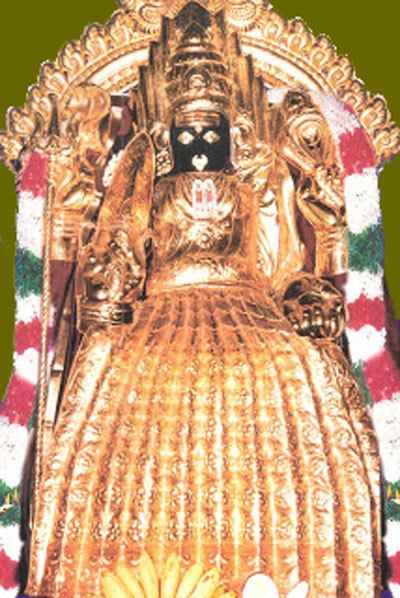
She caught smallpox and begged from house to house for food, fanning herself with leaves of the neem or margosa tree to keep the flies off her sores. One story about the origin of Maariamman is she was the wife of Thiruvalluvar, the Tamil poet, who was an outcast. In this self-realization he or she is bonded with the goddess, which is the underlining reason of the worship. Through this worship each individual realizes themselves and others through samsara and moksha. Some put themselves through a special tribulation of having one of the sacred weapons, dagger, trident, or a spear, inserted through their cheeks or tongues. Larger men and women carry pots of charcoal fire. Young men and women carry similar pots but are followed by drummers and dance more wildly. Many women and children carry a pot on their heads decorated with the goddess’s favourite leaves of the margosa tree. Countless people in the crowd have fasted, shaved their heads, and wear bright yellow clothes, which are sacred to the goddess. A hurried walk and dance carries hundreds of thousands of worshippers along the road to the temple. But the main worshipping of the goddess occurs on the road a mile or two from the temple.

Some continue to use an old village customs of worship by offering chickens and goats to the deity, but the animals are no longer sacrificed but sold after being offered. worship 1įor Mariyamman is a ten-day festival, organized by temple authorities during the second week in April. In Tamil, the word 'Maari' would still seen today for the worship of Mariyamman. the Sangam literature, there is an elaborate description of At the temple of Samayapuram, which lies six miles to the rites performed by the Kurava priestess in the shrine the north of Tirucirapalli, the Hindu system of worship is Palamutircholai. The temples of the Sangam days, fire walking and mouth or nose piercing are also pracmainly of Madurai, seem to have had priestesses to the deity, which also appear predominantly a goddess. This mother as Pongal and Koozh that are cooked using earthen pots goddess was conceived as a virgin, one who has given are also made during the festive season. Offerings such tion of a society which venerated femininity. often accomThe cult of the mother goddess is treated as an indica- The worshiping methods are non-vedic and panied by various kinds of folk dancing. Goddess Mariamman and Goddess 2 Worship Kali are closely associated with each other. Māri is closely associated with the Hindu goddesses Parvati and Durga as well as with her North Indian counterpart Shitaladevi and Eastern Indian counterpart Manasa. She is the main to them as their vegetation was mainly dependent upon Tamil mother goddess, predominant in the rural areas of rain.

She was believed and worshipped Mariamman is an Tamil folk goddess, whose worship by the ancient Tamils to bring rain and hence prosperity probably originated in pre-vedic India. Mean rain and 'amman' would literally mean mother but here “mother nature.”. Mariyamman in Tirisool, 10th century, chola peroid,Tamil Nadu,India. She is usually taken in procession in a decorated chariot. According to shaktha agamas, she is depicted in sitting posture and might be flanked some times by Ganesha and Subramaniya or Ganesha and Naaga on her sides.

She is worshipped in accordance to the local agamas as “Pidari” or the “Grama Devata” usually by non-Brahmin priests or in some cases of big temples like Samayapuram Maariamman temple, also by Brahmin priests. Her worship mainly focuses on bringing rains and curing diseases like cholera, smallpox, and chicken pox. Throughout the Tamil Nadu and deccan region, grand festival known as “Aadi Thiruvizha” are taken for Maariamman. Festivities for her happen during the late summer, early autumn season of “Aadi”. It is said that when Kali went to Southern India as Mariamman, Bhairava followed her as Madurai Veeran. Goddess Mariamman is considered by many to be the South Indian Incarnation of Goodess Kali. Māri is closely associated with the Hindu goddesses Parvati and Durga as well as with her North Indian counterpart Shitaladevi. She is the main South Indian mother goddess, predominant in the rural areas of Tamil Nadu, Karnataka, Andhra Pradesh and Maharashtra.

Mariamman Māri (Tamil: மாரி), also known as Mariamman (Tamil: மாரியம்மன்) and Mariaai (Marathi: मरी आई), both meaning “Mother Mari”, spelt also Maariamma (Tamil: மாரியம்மா), or simply Amman or Aatha (Tamil: அம்மன், “mother”) is the South Indian Hindu goddess of rain.


 0 kommentar(er)
0 kommentar(er)
